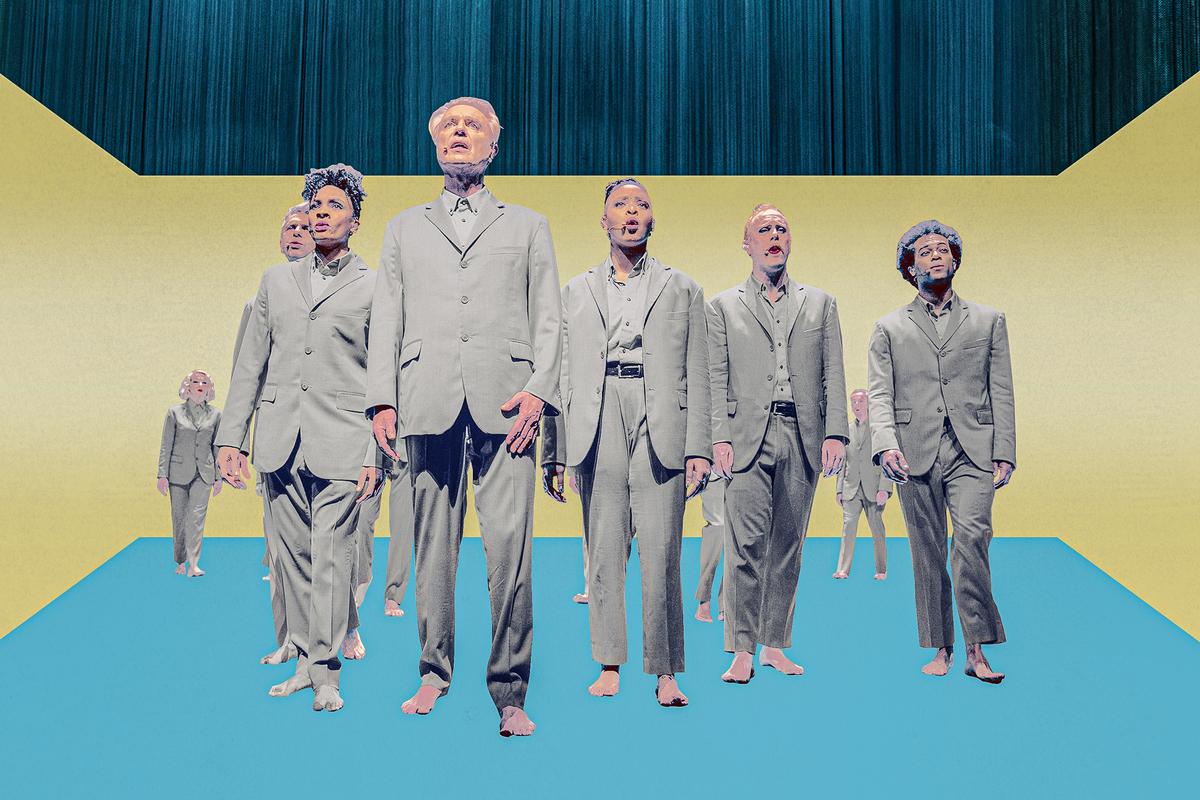
Probably it means something that David Byrne’s best-ever duet partner is still a lamp. Specifically, the floor lamp with which he tangoes near the end of “This Must Be the Place (Naive Melody),” jogging in place and coaxing it gently to the floor and wrapping his arms around it with a beatific smile during the best part of the best song from the Talking Heads’ 1984 monolith Stop Making Sense, still the best concert movie ever born. Incredible chemistry. Relationship goals. As it bathes his face in celestial light, Byrne nudges the lamp about with an anxious, baffled grace at the climax of a serene electro-pop love song with enough staying power that I saw somebody quote it—“And you love me till my heart stops / Love me till I’m dead”—in an Instagram wedding announcement this past weekend. Some love affairs really do last forever.
This is my own profession of love; this is my confession of bias. This is my explanation for why, when confronted once again by “This Must Be the Place” early in the film adaptation of Byrne’s new freewheeling Broadway musical American Utopia, I spent the entire tune full-on crying. That’s tears of joy, and (still!) tears of bafflement. I love this song, this band, this person, even if Byrne himself, as the Talking Heads’ electrifying and inherently inscrutable frontman, is the reason the beloved NYC quartet, which spent 15-odd years redefining genres from prep-school punk to top 40 pop to worldly art rock before breaking up in 1991, will never reunite, given his stubborn insistence on Moving Forward.
To hear his still-miffed Talking Heads bandmates tell it, this guy vibes a little better with lamps than with people. But that cheerful struggle for genuine human connection—“I’m just an animal looking for a home and / Share the same space for a minute or two”—is what makes the whole of American Utopia so moving. It’s a defiantly goofy spectacle that involves Byrne and up to 11 singers and dancers and backing musicians barefoot in matching gray suits, many wielding cartoon marching band percussion instruments, bouncing merrily around a stage usually stripped of all furnishings. Yes, even lamps. Objects are just distractions.
“Objectively, I could never figure out why looking at a person should be any more interesting than looking at any other thing,” he tells the audience—the front-row fans themselves usually on their feet, dancing—as the synth-bass line to “This Must be the Place” thrums in the background. “Like, say, a bicycle, or a beautiful sunset, or a nice bag of potato chips. But yeah, looking at people: That’s the best.” Byrne (still!) doesn’t quite yet sound convinced himself. But the dazed, profound whimsy of his voice has always been awfully convincing.
Another confession: I tend to cry, or at least tear up, at all musical theater, on principle: something about the overwhelming collective euphoric whoosh that somehow only musical theater provides. Directed by Spike Lee (!!) and premiering on HBO Saturday night, American Utopia began life as a reliably playful 2018 solo album, then a lengthy national tour, then an initial Broadway run from October 2019 to February 2020, wrapping up just before COVID-19 darkened Broadway across the board. That heartbreaking absence—of virtually all live music and theater, though American Utopia hopes to return to the stage eventually—is part of what makes the movie so sublimely bittersweet. You get just enough of a taste of that euphoria to know how much you’re still missing.
The set list is a career-spanning collection of 20-odd tunes—about half of them Talking Heads classics and deep cuts, because sometimes you gotta reach backward to Move Forward—interspersed with Byrne’s genial observations on the human brain, and the Dada movement, and television (he used to watch a lot), and voting (he wishes more people did). There are no big ideas beyond We’re All Connected, and Be Nicer to Each Other, and also, well, Vote. Meanwhile, I was tearing up from the first few moments of “Here,” the American Utopia album closer now refashioned as the sweetly droning show opener, with Byrne holding a plastic brain and holding forth with an almost comically plainspoken wonder that’s still all his own:
Here is an area of great confusion
Here is a section that’s extremely precise
And here is an area that needs attention
Here is a connection with the opposite side
If you’re coming to American Utopia mostly for the Talking Heads megahits, you do get ’em: an extra-buoyant “Once in a Lifetime” halfway through, a relatively laid-back “Burning Down the House” close to the end, and an affably exhausted “Road to Nowhere” as the march-through-the-aisles grand finale. These songs are forever bulletproof—proof that some pop music only gets catchier as it gets weirder—though this new band, as charismatic and propulsive as it might be, isn’t even trying to top the Talking Heads versions. You almost feel better when they’re attacking lesser-known songs that consequently they can make their own, whether it’s the dance-party ecstasy of “Toe Jam” (first a 2008 collaboration with the Brighton Port Authority and Dizzee Rascal) or a slight American Utopia original like “I Dance Like This,” which commits to its silliness with such intensity it approaches heavy metal.
That dancing—or at least Byrne’s dancing—is great not so much for its intricacy as for its childlike simplicity. (Deprived of his beloved lamp, his primary move during “This Must Be the Place” is best described as “invisible maracas.”) Byrne’s collaborators here (particularly the dancers and singers Chris Giarmo and Tendayi Kuumba) are such a blissful whirlwind that Byrne, who is 68 and thankfully not working terribly hard to hide it, can duck in and out of the spotlight. Sometimes he runs one hand through his resplendent white hair, a casual, relatable movement from a rock star not predisposed to casual, relatable movements. He introduces a more recent tune called “Everybody’s Coming to My House” by noting when he sings it it’s clear he’s uncomfortable with the idea of everybody coming to his house. No matter his age or who’s standing with him onstage, he’s always been pulling you closer with one hand and pushing you away with the other.
I have spent four decades fascinated by this person: the pop star and the recovering pop star, the cuddly frontman and the prickly ex-bandmate. Talking Heads drummer Chris Frantz’s new autobiography, Remain in Love, takes every opportunity to paint Byrne as a standoffish, power-hungry weirdo: Judgments about Byrne range from “he seems incapable of returning friendship” (that’s a quote from Frantz’s wife, Talking Heads bassist Tina Weymouth) to “his eccentricities were not an act” to “David was happiest when things were not comfortable.” Even the band’s induction into the Rock & Roll Hall of Fame was ultimately a fraught occasion; reunited, they could very likely headline, say, Coachella if Coachella ever happens again, but Byrne shoots down such ideas at every opportunity. The uncomplicated bliss of Talking Heads is all the more fascinating for how complicated and combative the band dynamic could be.
Byrne has thus spent the past 30 years doing seemingly anything that strikes his fancy, whether it’s a musical about Imelda Marcos or a book about his love of bicycling or an album-length collaboration with St. Vincent or a giant pipe organ he had installed in lower Manhattan or another book called The New Sins that he secretly placed in hotel rooms in place of the Bible. At New York City cultural events, it has long been a badge of honor to spot his shock of white hair in the audience, or to catch his bike whizzing off down the street immediately afterward. He is seemingly everywhere, and disconcertingly guileless and open, and yet fundamentally unknowable.
But American Utopia is the ideal collision of the past that made him famous, the present tense he insists on living in, and the future he’s still imagining. A few moments in the show are bluntly political, including an uncharacteristically fiery cover of Janelle Monáe’s protest song “Hell You Talmbout” that shouts out victims of police violence, stretching from Amadou Diallo to Freddie Gray all the way to George Floyd and Breonna Taylor. He’s a little less naive these days, but still hopeful nonetheless. Right before the forever-prophetic “Road to Nowhere,” he quotes James Baldwin (“I still believe that we can do with this country something that has not been done before”) and declares America a work in progress. And then, with not a little bit of whimsy, he gets on with the work.
That work does involve, for one part of one song, a lamp: It’s more of a torch, really, a single bulb that illuminates him during a somber American Utopia original called “Bullet,” which describes violence and pain with the same straightforward candor he uses to describe everything. “The bullet went into him / His skin did part in two / Skin that women had touched / The bullet passed on through.” David Byrne is just standing there, dead-center stage, as his bandmates walk in slow, somber circles around him. It’s remarkable how it still looks like he’s dancing, even when he’s completely still.

